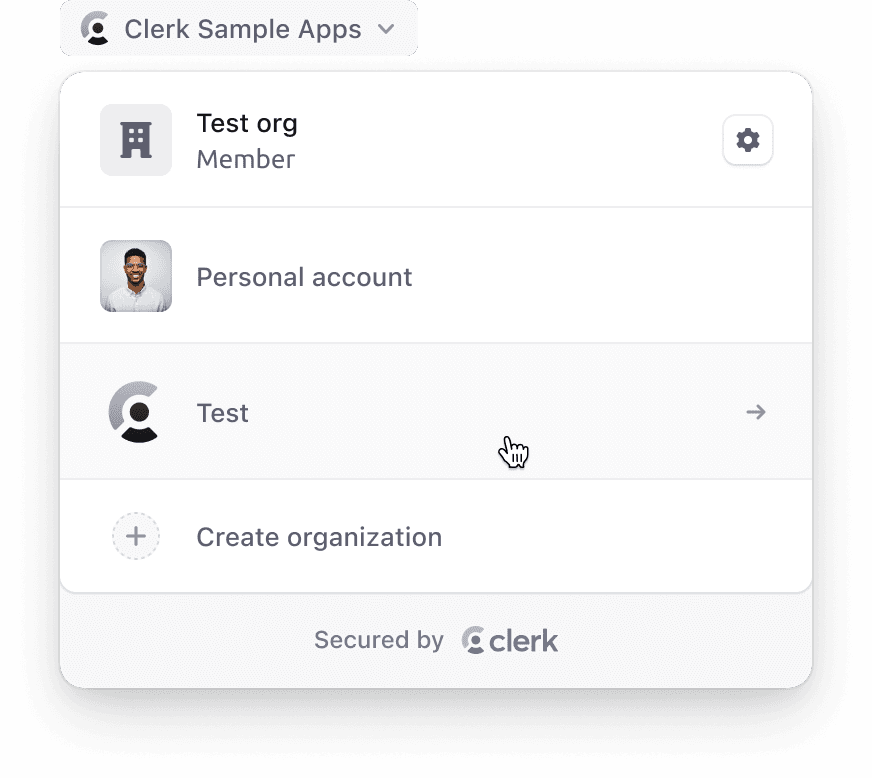<OrganizationSwitcher /> component

The <OrganizationSwitcher /> component allows a user to switch between their account types - their personal account and their joined organizations. This component is useful for applications that have a multi-tenant architecture, where users can be part of multiple organizations. It handles all organization-related flows, including full organization management for admins. Learn more about organizations.
If you would like to learn how to hide a user's personal account in order to enforce an organization-centric application, see the dedicated guide.
Properties
The <OrganizationSwitcher /> component accepts the following properties, all of which are optional:
- Name
afterCreateOrganizationUrl- Type
string- Description
The full URL or path to navigate to after creating a new organization.
- Name
afterLeaveOrganizationUrl- Type
string- Description
The full URL or path to navigate to after the user leaves the currently active organization.
- Name
afterSelectOrganizationUrl- Type
string- Description
The full URL or path to navigate to after a successful organization switch.
- Name
appearance- Type
Appearance | undefined- Description
Optional object to style your components. Will only affect Clerk components and not Account Portal pages.
- Name
createOrganizationMode- Type
'modal' | 'navigation'- Description
A boolean that controls whether clicking the "Create organization" button will cause the
<CreateOrganization />component to open as a modal, or if the browser will navigate to thecreateOrganizationUrlwhere<CreateOrganization />is mounted as a page. Defaults to:'modal'.
- Name
createOrganizationUrl- Type
string- Description
The full URL or path where the
<CreateOrganization />]createorg-ref component is mounted.
- Name
defaultOpen- Type
boolean- Description
A boolean that controls the default state of the
<OrganizationSwitcher />component.
- Name
fallback?- Type
ReactNode- Description
An optional element to be rendered while the component is mounting.
- Name
hidePersonal- Type
boolean- Description
A boolean that controls whether
<OrganizationSwitcher />will include the user's personal account in the organization list. Setting this totruewill hide the personal account option, and users will only be able to switch between organizations. Defaults tofalse.
- Name
hideSlug- Type
boolean- Description
A boolean that controls whether the optional slug field in the organization creation screen is hidden.
- Name
organizationProfileMode- Type
'modal' | 'navigation'- Description
A boolean that controls whether clicking the Manage organization button will cause the
<OrganizationProfile />component to open as a modal, or if the browser will navigate to theorganizationProfileUrlwhere<OrganizationProfile />is mounted as a page. Defaults to:'modal'.
- Name
organizationProfileProps- Type
object- Description
Specify options for the underlying
<OrganizationProfile />component. For example:{appearance: {...}}
- Name
organizationProfileUrl- Type
string- Description
The full URL or path where the
<OrganizationProfile />component is mounted.
import { OrganizationSwitcher } from '@clerk/nextjs'
export default function OrganizationSwitcherPage() {
return <OrganizationSwitcher />
}import { OrganizationSwitcher } from '@clerk/clerk-react'
export default function OrganizationSwitcherPage() {
return <OrganizationSwitcher />
}---
import { OrganizationSwitcher } from '@clerk/astro/components'
---
<OrganizationSwitcher />import { OrganizationSwitcher } from '@clerk/remix'
export default function OrganizationSwitcherPage() {
return <OrganizationSwitcher />
}import { OrganizationSwitcher } from '@clerk/tanstack-react-start'
import { createFileRoute } from '@tanstack/react-router'
export const Route = createFileRoute('/organization-switcher')({
component: OrganizationSwitcher,
})
function OrganizationSwitcher() {
return <OrganizationSwitcher />
}<script setup lang="ts">
import { OrganizationSwitcher } from '@clerk/vue'
</script>
<template>
<OrganizationSwitcher />
</template>Usage with JavaScript
The following methods available on an instance of the Clerk class are used to render and control the <OrganizationSwitcher /> component:
The following examples assume that you have followed the quickstart in order to add Clerk to your JavaScript application.
mountOrganizationSwitcher()
Render the <OrganizationSwitcher /> component to an HTML <div> element.
function mountOrganizationSwitcher(node: HTMLDivElement, props?: OrganizationSwitcherProps): void- Name
node- Type
HTMLDivElement- Description
The
<div>element used to render in the<OrganizationSwitcher />component
- Name
props?- Type
OrganizationSwitcherProps- Description
The properties to pass to the
<OrganizationSwitcher />component
import { Clerk } from '@clerk/clerk-js'
// Initialize Clerk with your Clerk Publishable Key
const clerkPubKey = import.meta.env.VITE_CLERK_PUBLISHABLE_KEY
const clerk = new Clerk(clerkPubKey)
await clerk.load()
document.getElementById('app').innerHTML = `
<div id="organization-switcher"></div>
`
const orgSwitcherDiv = document.getElementById('organization-switcher')
clerk.mountOrganizationSwitcher(orgSwitcherDiv)unmountOrganization
Unmount and run cleanup on an existing <OrganizationSwitcher /> component instance.
function unmountOrganizationSwitcher(node: HTMLDivElement): void- Name
node- Type
HTMLDivElement- Description
The container
<div>element with a rendered<OrganizationSwitcher />component instance
import { Clerk } from '@clerk/clerk-js'
// Initialize Clerk with your Clerk Publishable Key
const clerkPubKey = import.meta.env.VITE_CLERK_PUBLISHABLE_KEY
const clerk = new Clerk(clerkPubKey)
await clerk.load()
document.getElementById('app').innerHTML = `
<div id="organization-switcher"></div>
`
const orgSwitcherDiv = document.getElementById('organization-switcher')
clerk.mountOrganizationSwitcher(orgSwitcherDiv)
// ...
clerk.unmountOrganizationSwitcher(orgSwitcherDiv)Customization
To learn about how to customize Clerk components, see the customization documentation.
Feedback
Last updated on